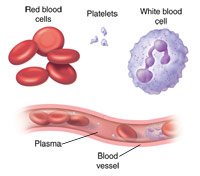WebMD.org
Blood is the fluid of life.
Red Blood Cells
It pumps about 55-80 ml (1/3 cup) of blood with each beat for adults and around 25-85 ml per beat for children.
An adult heart pumps about 6,000-7,500 liters
(1,500-2,000 gallons) of blood daily.
The average adult body contains about five quarts of blood which continually circulates throughout the body.
💖💖💖💖💖💖💙💙💙💙💙💟💟💟💟💟💟💚💚💚💚💚💚
Plasma: The liquid part of the blood and lymphatic fluid, which makes up about half of the volume of blood.
Plasma is devoid of cells and, unlike serum, has not clotted. Blood plasma contains antibodies and other proteins.
It is taken from donors and made into medications for a variety of blood-related conditions.

What Is Plasma?
Plasma is the often forgotten component of blood. White blood cells, red blood cells,
and platelets are essential to body function, but plasma also plays a crucial, and
mostly unrecognized, job.
It carries these blood components throughout the body as
the fluid in which they travel.
Plasma makes up the biggest part of your blood: about 55%. Even though
blood appears red when you see it outside the body, plasma itself is a
pale yellow color.
It’s the liquid part of your blood. One of its jobs is keeping your blood pressure in a healthy range.
It also carries important proteins, minerals, nutrients, and hormones to the right places in your body.
No comments:
Post a Comment